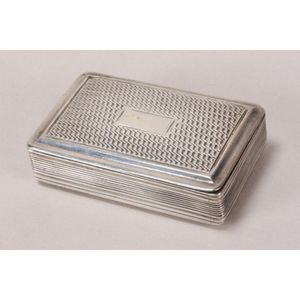Georgian Silver Vinaigrette, Birmingham 1825
You must be a subscriber, and be logged in to view price and dealer details.
Subscribe Now to view actual auction price for this item
When you subscribe, you have the option of setting the currency in which to display prices to $Au, $US, $NZ or Stg.
- George Iv - George IV (1762 ? 1830) was king of the United Kingdom of Great Britain and Ireland and king of Hanover from 1820, until his own death in 1830. From 1811 until his accession in 1820, he served as Prince Regent during his father's final mental illness.
In English furniture design, his reign from 1811 to 1830 is known as the Regency period. - Gilding - Gilding is a method of ornamentation whereby a thin sheet of gold metal is applied to items made of wood, leather, ceramics, glass and silver for decorative purposes.
For furniture including mirrors, the sheet of gold is usually applied over a coating of gesso. Gesso is a mixture of plaster of Paris and gypsum mixed with water and then applied to the carved wooden frames of mirrors and picture frames as a base for applying the gold leaf. After numerous coats of gesso have been applied, allowed to dry and then sanded a coat of "bole", a usually red coloured mixture of clay and glue is brushed on and allowed to dry, after which the gold leaf is applied. Over time parts of the gilding will rub off so the base colour can be seen. In water gilding, this was generally a blue colour, while in oil gilding, the under layer was often yellow. In Victorian times, gilders frequently used red as a pigment beneath the gold leaf.
Metal was often gilded by a process known as fire gilding. Gold mixed with mercury was applied and heated, causing the mercury to evaporate, the long-term effect of which was to kill or disable the craftsman or woman from mercury poisoning. The pursuit of beauty has claimed many victims, not the least of which were the artists who made those pieces so highly sought after today. - Sterling Silver - Sterling silver is a mixture of 92.5% pure silver and 7.5% of another metal, usually copper. Fine silver is 99.9% pure silver, and is relatively soft and the addition of the very small amount of copper gives the metal enough strength and hardness to be worked into jewellery, decorative and household objects.
This item has been included into following indexes:
Visually similar items

George IV sterling silver snuff box and cover, hallmarked, Birmingham, 1825. I.B (John Bettridge), of rectangular form, with central reserve surrounded by engraved surface and reeded sides, opening to gilt interior, total weight 49gm, 6.3 cm x 4 cm

George III sterling silver snuff box and cover, hallmarked, Birmingham, 1805, I.S (John Shaw), of rectangular curved form, with a reeded surface, total weight 37gm, length 5.7 cm

George IV sterling silver snuff box and cover, hallmarked, Birmingham, 1827, I.T (Joseph Taylor), of rectangular form, with central vacant reserve, surrounded by reeded ground and floral thumb pieces, opening to gilt interior, total weight 49gm, 5.5 cm x 3

An Edward VII sterling silver embossed rectangular jewel casket by William Comyns, London 1902, profusely decorated with swags, scrolls and classical masks, 28 x 14 cm, 8 cm high
